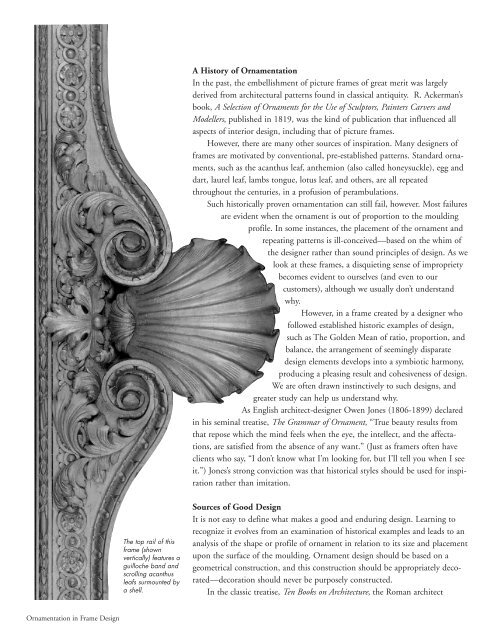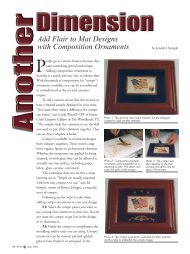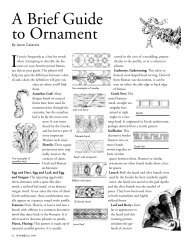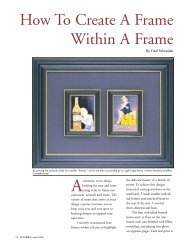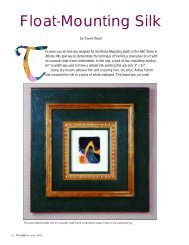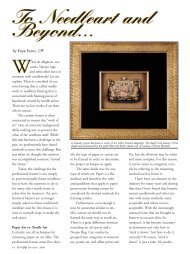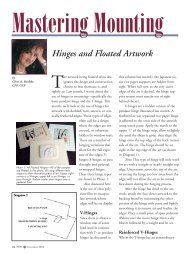PICTURE FRAMING MAGAZINE Ornamentation In Frame Design
PICTURE FRAMING MAGAZINE Ornamentation In Frame Design
PICTURE FRAMING MAGAZINE Ornamentation In Frame Design
You also want an ePaper? Increase the reach of your titles
YUMPU automatically turns print PDFs into web optimized ePapers that Google loves.
<strong>Ornamentation</strong> in <strong>Frame</strong> <strong>Design</strong><br />
The top rail of this<br />
frame (shown<br />
vertically) features a<br />
guilloche band and<br />
scrolling acanthus<br />
leafs surmounted by<br />
a shell.<br />
A History of <strong>Ornamentation</strong><br />
<strong>In</strong> the past, the embellishment of picture frames of great merit was largely<br />
derived from architectural patterns found in classical antiquity. R. Ackerman’s<br />
book, A Selection of Ornaments for the Use of Sculptors, Painters Carvers and<br />
Modellers, published in 1819, was the kind of publication that influenced all<br />
aspects of interior design, including that of picture frames.<br />
However, there are many other sources of inspiration. Many designers of<br />
frames are motivated by conventional, pre-established patterns. Standard ornaments,<br />
such as the acanthus leaf, anthemion (also called honeysuckle), egg and<br />
dart, laurel leaf, lambs tongue, lotus leaf, and others, are all repeated<br />
throughout the centuries, in a profusion of perambulations.<br />
Such historically proven ornamentation can still fail, however. Most failures<br />
are evident when the ornament is out of proportion to the moulding<br />
profile. <strong>In</strong> some instances, the placement of the ornament and<br />
repeating patterns is ill-conceived—based on the whim of<br />
the designer rather than sound principles of design. As we<br />
look at these frames, a disquieting sense of impropriety<br />
becomes evident to ourselves (and even to our<br />
customers), although we usually don’t understand<br />
why.<br />
However, in a frame created by a designer who<br />
followed established historic examples of design,<br />
such as The Golden Mean of ratio, proportion, and<br />
balance, the arrangement of seemingly disparate<br />
design elements develops into a symbiotic harmony,<br />
producing a pleasing result and cohesiveness of design.<br />
We are often drawn instinctively to such designs, and<br />
greater study can help us understand why.<br />
As English architect-designer Owen Jones (1806-1899) declared<br />
in his seminal treatise, The Grammar of Ornament, “True beauty results from<br />
that repose which the mind feels when the eye, the intellect, and the affectations,<br />
are satisfied from the absence of any want.” (Just as framers often have<br />
clients who say, “I don’t know what I’m looking for, but I’ll tell you when I see<br />
it.”) Jones’s strong conviction was that historical styles should be used for inspiration<br />
rather than imitation.<br />
Sources of Good <strong>Design</strong><br />
It is not easy to define what makes a good and enduring design. Learning to<br />
recognize it evolves from an examination of historical examples and leads to an<br />
analysis of the shape or profile of ornament in relation to its size and placement<br />
upon the surface of the moulding. Ornament design should be based on a<br />
geometrical construction, and this construction should be appropriately decorated—decoration<br />
should never be purposely constructed.<br />
<strong>In</strong> the classic treatise, Ten Books on Architecture, the Roman architect


